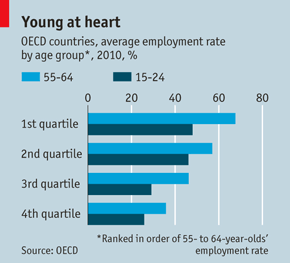By Lisa Taylor
As the founder of Challenge Factory, Canada’s leading career company for the 50+ workforce, I’m often asked if I feel any responsibility towards youth in this country who struggle to find decent work. “Isn’t irresponsible to focus on retaining 50+ workers in the workforce when there are so many recent graduates who need jobs?”
My response is always the same. Of course I’m concerned about young people struggling to find jobs, but that is not related to the over 55 employment issue because jobs are not a zero sum game. Quite the opposite; increasing employment for one population increases employment for all. Our ageing workforce is not the cause of youth unemployment simply because both trends are occurring at the same time. We have two distinct workforce issues happening simultaneously, each needing their own analysis and solution.
Matt Sedensky, a fellow at the AP-NORC Center for Public Affairs Research, shared the frustration economists feel over the lack of understanding of this issue in a recent article. “Having older people active and productive actually benefits all age groups…and spurs the creation of more jobs. [Economists] Munnell and Wu analyzed Current Population Survey data to test for any changes in employment among those under 55 when those 55 and older worked in greater numbers. They found no evidence younger workers were losing work and in fact found the opposite: Greater employment reduced unemployment and yielded higher wages.”
 The belief that there are a limited number of jobs in the economy and, therefore, one group’s employment level is at the expense of another’s is called the “lump of labour” fallacy and has been described, explained, and demonstrated in more than a century of research and economic theory. One population does not enter or stay in the workforce at the expense of another. It was not true for immigrant workers. It was not true for women. It is not true for older workers. A February 2012 article in The Economist shared OECD country data demonstrates that countries with higher older worker employment have higher youth employment.
The belief that there are a limited number of jobs in the economy and, therefore, one group’s employment level is at the expense of another’s is called the “lump of labour” fallacy and has been described, explained, and demonstrated in more than a century of research and economic theory. One population does not enter or stay in the workforce at the expense of another. It was not true for immigrant workers. It was not true for women. It is not true for older workers. A February 2012 article in The Economist shared OECD country data demonstrates that countries with higher older worker employment have higher youth employment.
Note that the average employment rates of youth and the 55+ cohorts rise and fall together. Study after study presents data that demonstrates this economic principle. Yet it has never been accepted by the general public.
So let’s look at the myth of older workers taking employment opportunities from the young.
Data analytics drive business strategy
Over the last few decades, analytics has become the backbone of many corporate functions. Logistics, operations, IT, marketing, and customer service now all rely on analytics when creating strategies and measuring business results. HR and workforce planning is well behind the curve in coming to the data-driven table. Lamentably, in HR practice, facts, data and analysis are still often overruled by common wisdom under the assumption that such cold and clinical approaches don’t apply as much to people as they do to production lines or enterprise systems.
At the beginning of the Internet Revolution, it was hard to predict how new technology would affect business. Similarly, we are entering the era of a Talent Revolution and it is hard to predict the future of labour or how the workforce of the future will be structured. However, in an era of uncertainty, data is king. Rejecting economic wisdom due to a single experience in one company or basing decisions purely on “common sense” may be the difference between success and failure, between those who innovate through this revolution and those that disappear.
Recommendation 1: Know your numbers and test intuition with logic
Every leadership development session emphasizes the importance of knowing your numbers and using facts to drive decisions.
So let’s apply it here. The data and logic just don’t support the notion that older workers take jobs from the young. For that to be true, there would have to be a limited number of jobs to be had in the economy, which we know isn’t the case. It also implies that somehow keeping qualified and productive workers idle and supported by younger workers allows others to pick up the slack while still keeping the economy strong.
Organizations should use data to identify how the workforce is a critical growth engine. If the assumption that delayed retirement will hinder new graduate success is false at the macro level, what is the reality within your organization? What other faulty assumptions are at the heart of your enterprise workforce planning strategy?
Leading the economy with a rearview mirror
If leaders base their workforce strategy on perceptions that are no longer valid, I’d argue they are fixing the wrong problems. Many technological, social, and economic factors have caused a shift in the lifecycle of our careers. New talent patterns include career development well into our 70s with various flexible paths to take. Programs that solve problems using talent wisdom from the one-career-one-company era of the 1960s, no matter how well executed, aren’t addressing today’s need to increase productivity, innovation and competitiveness.
Over the last five years, several sectors have put significant emphasis on new graduate recruitment. But at the same time, there are massive concerns about the impact of the impending wave of retirements. The insurance industry has a program to hire young graduates that has been very successful and the sector is a healthy employer of new talent. Yet, they still worry about the loss of experience, judgement and corporate memory with masses getting set to retire. As highlighted in Sedensky’s article, younger workers simply cannot be assumed to replace retiring workers. The need for seasoned workers and new talent resources have both increased.
Recommendation 2: Fix Broken Talent Escalators™
Companies have Broken Talent Escalators™ that assume once you hit a certain age and have ridden the escalator, you will step off at the top and everyone will move up. In reality, most organizations don’t work this way anymore and employees want a less linear approach to their career—at any age. We need realistic views that recognize that working life expectancy is increasing, career paths will extend well beyond the traditional age of retirement, and workers will change direction, if not careers, several times in their working life.
Challenge Factory: The ageing workforce “snopes”
Just like the economists in Sedensky’s article, I’m astonished that after 150 years, the myth of jobs as a zero sum game has not been conclusively dispelled. We need to grasp this essential and foundational concept if we are to create effective talent strategies for the technology age.
Snopes.com is a popular website that debunks urban legends. It’s time to sic them on this particular misunderstanding. The myth that older workers remain in the workforce at the expense of younger workers is way past due to be debunked. Challenge Factory is passionate about helping Canadian organizations implement talent solutions that are fact-based and drive innovation. We’re not advocating for the participation of older experienced workers at the expense of youth, but ultimately for the benefit of all, including youth.
Challenge Factory challenges outdated career thinking, bringing practical business experience to complex workforce issues. We focus on helping companies capitalize on the ageing workforce and help boomers launch Legacy Careers®.

